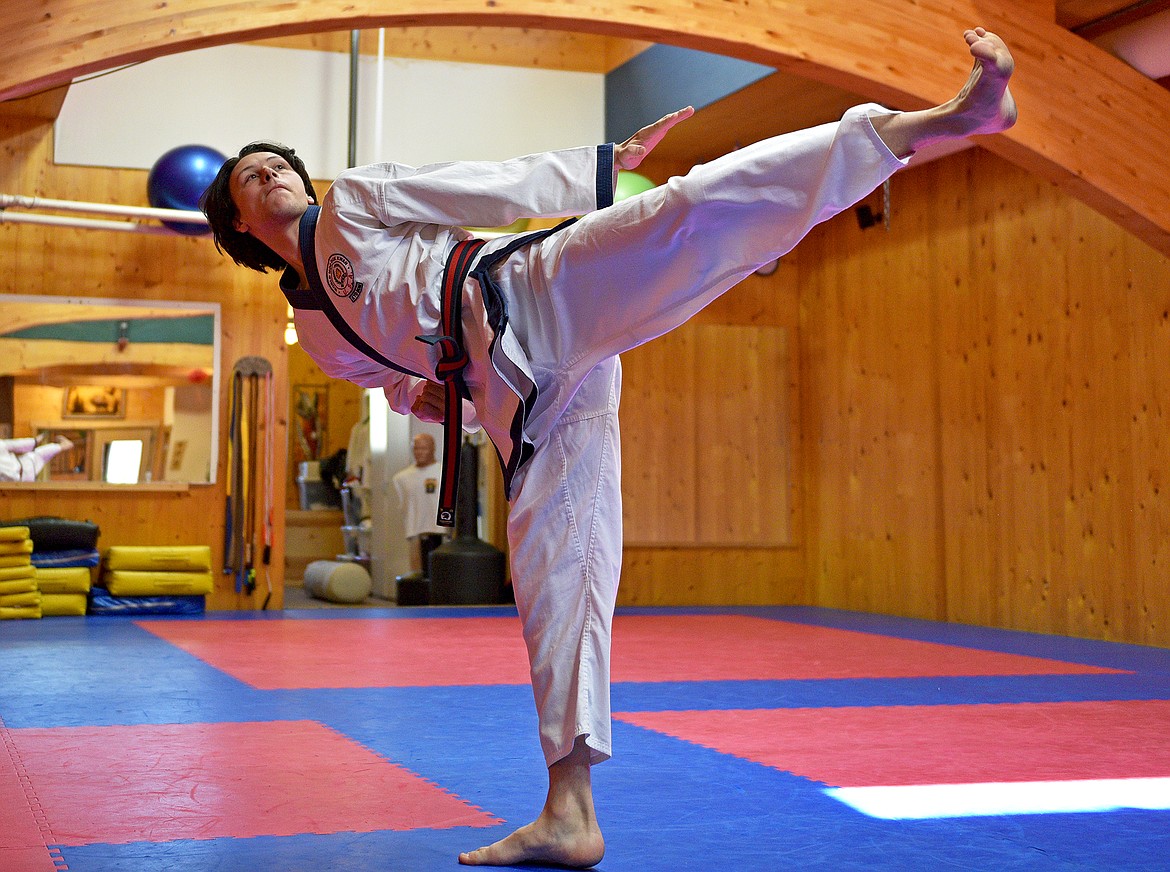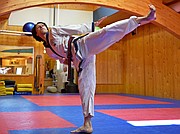Whitefish martial artist earns master level in Soo Bahk Do
Seventeen years of dedication to the Korean martial art of Soo Bahk Do has brought Tanner Armstrong to the fourth degree midnight blue belt, or Sa Dan, the first of the master levels.
He started training with Andy Hamer at the Sawbuck Do Jang in Whitefish when he was 5 years old and now teaches classes there.
“It's great for mental, spiritual and physical health,” he said. “It's not something that you have to start when you're five years old. It's something anyone can do and the benefits are endless.”
In 2019, Armstrong earned second place in Moo Do sparring and first in team sparring at a national competition in Portland. Although the COVID pandemic put competitions on hold, it did not diminish Armstrong’s determination to test for his fourth degree belt.
Armstrong first reached the high level of the midnight blue belt in 2011 when he was just 11 years old. In Soo Bahk Do, the midnight blue belt is similar to the black belt level of other martial arts such as Karate or Taekwondo.
Though he earned his first midnight blue belt at a young age, one is not considered a master until the fourth degree is earned. Four full years of training is required between the third and fourth degrees.
“The fourth degree test is always one of the hardest ones because you’re not a master yet,” Armstrong said. “Just wanting to be one.”
In Soo Bahk Do, when one earns the fourth degree a red stripe is added through the center of the midnight blue belt — signifying a master in the art.
”The red represents fire and the blue represents water so when one gets to the midnight blue belt things calm a little,” Hamer explained. ”Then the master level adds fire internally but blue, calm water externally.”
Armstrong’s test was held in Florida and lasted eight days. Students arrived and ran through the test on day one. The next six days were spent working on the details of their performance and receiving corrections.
“You are working with the grand master, the founder’s son. The best instructors in the art are working with us all day,” Armstrong said. “And then, your testing group is also training before the classes, after the classes and during the meals. You are with your group, training the whole time.”
Following the week of training, the students go through the test again and demonstrate everything they worked on throughout the week.
One section of the test requires the students to teach part of a class. Armstrong said it is intimidating to teach to your peers while the masters from all over the country are sitting in a circle, watching and grading you.
“That was one of my favorite moments at the test, when I was teaching, because I felt really confident and comfortable with what I was doing,” Armstrong recalls. “Most people say that it is the worst part of the test, the most stressful. But it was, for me, one of the most fun.”
Additionally, the test includes a written exam that tests for knowledge of the art’s history. Armstrong said during the week there is always a “dreaded” two-hour kicking class and a late-night training session that starts at 10 p.m.
The components of the exam that worried Armstrong were the endurance demanded and the preparation required. It was a matter of managing one and trusting in the other.
“Just trying to figure out how to keep your body going, how to not burn yourself out too quickly but still give it everything you've got,” Armstrong said. “I wanted this for so long and those nine months before the test, I kept trying to convince myself to back out because I didn't think I was prepared. I felt physically fit to do it but mentally, really scared.”
His mother, Tracy Armstrong, provided a calming voice over the phone throughout the months preceding the test and encouraged him to persevere. He also received a surprise visit during the exam from Hamer, his instructor, who flew to Florida to lend support.
“He’s always had the drive and excitement to continue training, to find places to train, to do things on his own and always improve,” said Hamer. “His self-motivation has been darned impressive.”
The grueling test ended after eight days and Armstrong had passed, earning his fourth degree midnight blue belt, also known as Sa Dan, the first of the master levels.
“The minute I finished it I was wishing it wasn't over. The idea of spending seven days when you don't focus on anything but training — it excites me,” Armstrong said. “I would definitely go back and do that test all over again and hopefully, in five years I can. It's just a phenomenal experience.”
The test was in November and testing officials sent out the results of the exam and feedback in early January. They did not send out the certificates for promotion until May, because, according to Armstrong, the founder of Soo Bahk Do didn’t believe in instant gratification.
He said when he got the belt, he felt the heaviness of being a master, yet didn't feel like a master. Hamer said that the fourth degree is, in a way, like restarting, like being a beginner again, and that may help explain Armstrong’s post-promotion feelings.
“Fourth degree and above is considered the master level. He’s well in front of a lot of people, but he’s at the back of a new pack.” Hamer said. “He’s moved to a new level, but at the same time he feels it already that he’s restarted. He’s beginning again at the master level.”
Discipline is a big part of the art of Soo Bahk Do. It also incorporates breathing techniques and meditations that have helped Armstrong stay calm and composed in a number of situations. He says the training has helped him mentally as well as physically.
“It still blows my mind. I have trouble wrapping my head around the fact that I'm this far,” he said. “But I realize I am quite fortunate to have something I've been doing this long that I've been passionate about.”





